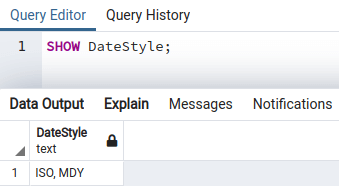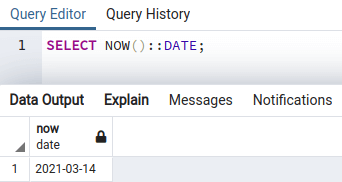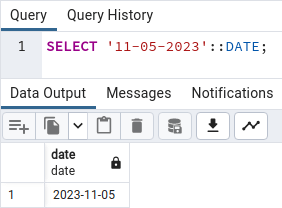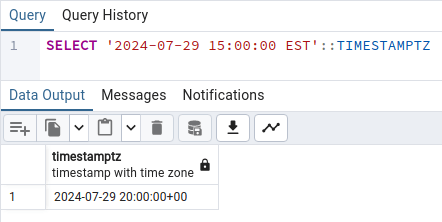- 1. API with NestJS #1. Controllers, routing and the module structure
- 2. API with NestJS #2. Setting up a PostgreSQL database with TypeORM
- 3. API with NestJS #3. Authenticating users with bcrypt, Passport, JWT, and cookies
- 4. API with NestJS #4. Error handling and data validation
- 5. API with NestJS #5. Serializing the response with interceptors
- 6. API with NestJS #6. Looking into dependency injection and modules
- 7. API with NestJS #7. Creating relationships with Postgres and TypeORM
- 8. API with NestJS #8. Writing unit tests
- 9. API with NestJS #9. Testing services and controllers with integration tests
- 10. API with NestJS #10. Uploading public files to Amazon S3
- 11. API with NestJS #11. Managing private files with Amazon S3
- 12. API with NestJS #12. Introduction to Elasticsearch
- 13. API with NestJS #13. Implementing refresh tokens using JWT
- 14. API with NestJS #14. Improving performance of our Postgres database with indexes
- 15. API with NestJS #15. Defining transactions with PostgreSQL and TypeORM
- 16. API with NestJS #16. Using the array data type with PostgreSQL and TypeORM
- 17. API with NestJS #17. Offset and keyset pagination with PostgreSQL and TypeORM
- 18. API with NestJS #18. Exploring the idea of microservices
- 19. API with NestJS #19. Using RabbitMQ to communicate with microservices
- 20. API with NestJS #20. Communicating with microservices using the gRPC framework
- 21. API with NestJS #21. An introduction to CQRS
- 22. API with NestJS #22. Storing JSON with PostgreSQL and TypeORM
- 23. API with NestJS #23. Implementing in-memory cache to increase the performance
- 24. API with NestJS #24. Cache with Redis. Running the app in a Node.js cluster
- 25. API with NestJS #25. Sending scheduled emails with cron and Nodemailer
- 26. API with NestJS #26. Real-time chat with WebSockets
- 27. API with NestJS #27. Introduction to GraphQL. Queries, mutations, and authentication
- 28. API with NestJS #28. Dealing in the N + 1 problem in GraphQL
- 29. API with NestJS #29. Real-time updates with GraphQL subscriptions
- 30. API with NestJS #30. Scalar types in GraphQL
- 31. API with NestJS #31. Two-factor authentication
- 32. API with NestJS #32. Introduction to Prisma with PostgreSQL
- 33. API with NestJS #33. Managing PostgreSQL relationships with Prisma
- 34. API with NestJS #34. Handling CPU-intensive tasks with queues
- 35. API with NestJS #35. Using server-side sessions instead of JSON Web Tokens
- 36. API with NestJS #36. Introduction to Stripe with React
- 37. API with NestJS #37. Using Stripe to save credit cards for future use
- 38. API with NestJS #38. Setting up recurring payments via subscriptions with Stripe
- 39. API with NestJS #39. Reacting to Stripe events with webhooks
- 40. API with NestJS #40. Confirming the email address
- 41. API with NestJS #41. Verifying phone numbers and sending SMS messages with Twilio
- 42. API with NestJS #42. Authenticating users with Google
- 43. API with NestJS #43. Introduction to MongoDB
- 44. API with NestJS #44. Implementing relationships with MongoDB
- 45. API with NestJS #45. Virtual properties with MongoDB and Mongoose
- 46. API with NestJS #46. Managing transactions with MongoDB and Mongoose
- 47. API with NestJS #47. Implementing pagination with MongoDB and Mongoose
- 48. API with NestJS #48. Definining indexes with MongoDB and Mongoose
- 49. API with NestJS #49. Updating with PUT and PATCH with MongoDB and Mongoose
- 50. API with NestJS #50. Introduction to logging with the built-in logger and TypeORM
- 51. API with NestJS #51. Health checks with Terminus and Datadog
- 52. API with NestJS #52. Generating documentation with Compodoc and JSDoc
- 53. API with NestJS #53. Implementing soft deletes with PostgreSQL and TypeORM
- 54. API with NestJS #54. Storing files inside a PostgreSQL database
- 55. API with NestJS #55. Uploading files to the server
- 56. API with NestJS #56. Authorization with roles and claims
- 57. API with NestJS #57. Composing classes with the mixin pattern
- 58. API with NestJS #58. Using ETag to implement cache and save bandwidth
- 59. API with NestJS #59. Introduction to a monorepo with Lerna and Yarn workspaces
- 60. API with NestJS #60. The OpenAPI specification and Swagger
- 61. API with NestJS #61. Dealing with circular dependencies
- 62. API with NestJS #62. Introduction to MikroORM with PostgreSQL
- 63. API with NestJS #63. Relationships with PostgreSQL and MikroORM
- 64. API with NestJS #64. Transactions with PostgreSQL and MikroORM
- 65. API with NestJS #65. Implementing soft deletes using MikroORM and filters
- 66. API with NestJS #66. Improving PostgreSQL performance with indexes using MikroORM
- 67. API with NestJS #67. Migrating to TypeORM 0.3
- 68. API with NestJS #68. Interacting with the application through REPL
- 69. API with NestJS #69. Database migrations with TypeORM
- 70. API with NestJS #70. Defining dynamic modules
- 71. API with NestJS #71. Introduction to feature flags
- 72. API with NestJS #72. Working with PostgreSQL using raw SQL queries
- 73. API with NestJS #73. One-to-one relationships with raw SQL queries
- 74. API with NestJS #74. Designing many-to-one relationships using raw SQL queries
- 75. API with NestJS #75. Many-to-many relationships using raw SQL queries
- 76. API with NestJS #76. Working with transactions using raw SQL queries
- 77. API with NestJS #77. Offset and keyset pagination with raw SQL queries
- 78. API with NestJS #78. Generating statistics using aggregate functions in raw SQL
- 79. API with NestJS #79. Implementing searching with pattern matching and raw SQL
- 80. API with NestJS #80. Updating entities with PUT and PATCH using raw SQL queries
- 81. API with NestJS #81. Soft deletes with raw SQL queries
- 82. API with NestJS #82. Introduction to indexes with raw SQL queries
- 83. API with NestJS #83. Text search with tsvector and raw SQL
- 84. API with NestJS #84. Implementing filtering using subqueries with raw SQL
- 85. API with NestJS #85. Defining constraints with raw SQL
- 86. API with NestJS #86. Logging with the built-in logger when using raw SQL
- 87. API with NestJS #87. Writing unit tests in a project with raw SQL
- 88. API with NestJS #88. Testing a project with raw SQL using integration tests
- 89. API with NestJS #89. Replacing Express with Fastify
- 90. API with NestJS #90. Using various types of SQL joins
- 91. API with NestJS #91. Dockerizing a NestJS API with Docker Compose
- 92. API with NestJS #92. Increasing the developer experience with Docker Compose
- 93. API with NestJS #93. Deploying a NestJS app with Amazon ECS and RDS
- 94. API with NestJS #94. Deploying multiple instances on AWS with a load balancer
- 95. API with NestJS #95. CI/CD with Amazon ECS and GitHub Actions
- 96. API with NestJS #96. Running unit tests with CI/CD and GitHub Actions
- 97. API with NestJS #97. Introduction to managing logs with Amazon CloudWatch
- 98. API with NestJS #98. Health checks with Terminus and Amazon ECS
- 99. API with NestJS #99. Scaling the number of application instances with Amazon ECS
- 100. API with NestJS #100. The HTTPS protocol with Route 53 and AWS Certificate Manager
- 101. API with NestJS #101. Managing sensitive data using the AWS Secrets Manager
- 102. API with NestJS #102. Writing unit tests with Prisma
- 103. API with NestJS #103. Integration tests with Prisma
- 104. API with NestJS #104. Writing transactions with Prisma
- 105. API with NestJS #105. Implementing soft deletes with Prisma and middleware
- 106. API with NestJS #106. Improving performance through indexes with Prisma
- 107. API with NestJS #107. Offset and keyset pagination with Prisma
- 108. API with NestJS #108. Date and time with Prisma and PostgreSQL
- 109. API with NestJS #109. Arrays with PostgreSQL and Prisma
- 110. API with NestJS #110. Managing JSON data with PostgreSQL and Prisma
- 111. API with NestJS #111. Constraints with PostgreSQL and Prisma
- 112. API with NestJS #112. Serializing the response with Prisma
- 113. API with NestJS #113. Logging with Prisma
- 114. API with NestJS #114. Modifying data using PUT and PATCH methods with Prisma
- 115. API with NestJS #115. Database migrations with Prisma
- 116. API with NestJS #116. REST API versioning
- 117. API with NestJS #117. CORS – Cross-Origin Resource Sharing
- 118. API with NestJS #118. Uploading and streaming videos
- 119. API with NestJS #119. Type-safe SQL queries with Kysely and PostgreSQL
- 120. API with NestJS #120. One-to-one relationships with the Kysely query builder
- 121. API with NestJS #121. Many-to-one relationships with PostgreSQL and Kysely
- 122. API with NestJS #122. Many-to-many relationships with Kysely and PostgreSQL
- 123. API with NestJS #123. SQL transactions with Kysely
- 124. API with NestJS #124. Handling SQL constraints with Kysely
- 125. API with NestJS #125. Offset and keyset pagination with Kysely
- 126. API with NestJS #126. Improving the database performance with indexes and Kysely
- 127. API with NestJS #127. Arrays with PostgreSQL and Kysely
- 128. API with NestJS #128. Managing JSON data with PostgreSQL and Kysely
- 129. API with NestJS #129. Implementing soft deletes with SQL and Kysely
- 130. API with NestJS #130. Avoiding storing sensitive information in API logs
- 131. API with NestJS #131. Unit tests with PostgreSQL and Kysely
- 132. API with NestJS #132. Handling date and time in PostgreSQL with Kysely
- 133. API with NestJS #133. Introducing database normalization with PostgreSQL and Prisma
- 134. API with NestJS #134. Aggregating statistics with PostgreSQL and Prisma
- 135. API with NestJS #135. Referential actions and foreign keys in PostgreSQL with Prisma
- 136. API with NestJS #136. Raw SQL queries with Prisma and PostgreSQL range types
- 137. API with NestJS #137. Recursive relationships with Prisma and PostgreSQL
- 138. API with NestJS #138. Filtering records with Prisma
- 139. API with NestJS #139. Using UUID as primary keys with Prisma and PostgreSQL
- 140. API with NestJS #140. Using multiple PostgreSQL schemas with Prisma
- 141. API with NestJS #141. Getting distinct records with Prisma and PostgreSQL
- 142. API with NestJS #142. A video chat with WebRTC and React
- 143. API with NestJS #143. Optimizing queries with views using PostgreSQL and Kysely
- 144. API with NestJS #144. Creating CLI applications with the Nest Commander
- 145. API with NestJS #145. Securing applications with Helmet
- 146. API with NestJS #146. Polymorphic associations with PostgreSQL and Prisma
- 147. API with NestJS #147. The data types to store money with PostgreSQL and Prisma
- 148. API with NestJS #148. Understanding the injection scopes
- 149. API with NestJS #149. Introduction to the Drizzle ORM with PostgreSQL
- 150. API with NestJS #150. One-to-one relationships with the Drizzle ORM
- 151. API with NestJS #151. Implementing many-to-one relationships with Drizzle ORM
- 152. API with NestJS #152. SQL constraints with the Drizzle ORM
- 153. API with NestJS #153. SQL transactions with the Drizzle ORM
- 154. API with NestJS #154. Many-to-many relationships with Drizzle ORM and PostgreSQL
- 155. API with NestJS #155. Offset and keyset pagination with the Drizzle ORM
- 156. API with NestJS #156. Arrays with PostgreSQL and the Drizzle ORM
- 157. API with NestJS #157. Handling JSON data with PostgreSQL and the Drizzle ORM
- 158. API with NestJS #158. Soft deletes with the Drizzle ORM
- 159. API with NestJS #159. Date and time with PostgreSQL and the Drizzle ORM
- 160. API with NestJS #160. Using views with the Drizzle ORM and PostgreSQL
- 161. API with NestJS #161. Generated columns with the Drizzle ORM and PostgreSQL
- 162. API with NestJS #162. Identity columns with the Drizzle ORM and PostgreSQL
- 163. API with NestJS #163. Full-text search with the Drizzle ORM and PostgreSQL
- 164. API with NestJS #164. Improving the performance with indexes using Drizzle ORM
- 165. API with NestJS #165. Time intervals with the Drizzle ORM and PostgreSQL
- 166. API with NestJS #166. Logging with the Drizzle ORM
- 167. API with NestJS #167. Unit tests with the Drizzle ORM
- 168. API with NestJS #168. Integration tests with the Drizzle ORM
- 169. API with NestJS #169. Unique IDs with UUIDs using Drizzle ORM and PostgreSQL
- 170. API with NestJS #170. Polymorphic associations with PostgreSQL and Drizzle ORM
- 171. API with NestJS #171. Recursive relationships with Drizzle ORM and PostgreSQL
- 172. API with NestJS #172. Database normalization with Drizzle ORM and PostgreSQL
- 173. API with NestJS #173. Storing money with Drizzle ORM and PostgreSQL
- 174. API with NestJS #174. Multiple PostgreSQL schemas with Drizzle ORM
- 175. API with NestJS #175. PUT and PATCH requests with PostgreSQL and Drizzle ORM
- 176. API with NestJS #176. Database migrations with the Drizzle ORM
- 177. API with NestJS #177. Response serialization with the Drizzle ORM
- 178. API with NestJS #178. Storing files inside of a PostgreSQL database with Drizzle
- 179. API with NestJS #179. Pattern matching search with Drizzle ORM and PostgreSQL
- 180. API with NestJS #180. Organizing Drizzle ORM schema with PostgreSQL
- 181. API with NestJS #181. Prepared statements in PostgreSQL with Drizzle ORM
- 182. API with NestJS #182. Storing coordinates in PostgreSQL with Drizzle ORM
- 183. API with NestJS #183. Distance and radius in PostgreSQL with Drizzle ORM
- 184. API with NestJS #184. Storing PostGIS Polygons in PostgreSQL with Drizzle ORM
- 185. API with NestJS #185. Operations with PostGIS Polygons in PostgreSQL and Drizzle
- 186. API with NestJS #186. What’s new in Express 5?
- 187. API with NestJS #187. Rate limiting using Throttler
Storing date and time in a database can be challenging, but it’s important to get it right. In this article, we solve this problem using PostgreSQL and the Drizzle ORM. We also delve into time zones and how to manage them in our database.
Managing dates with PostgreSQL
We can understand how our database handles dates by checking the DateStyle parameter.

The default setting for DateStyle is ISO, MDY. For information on other options, check out the official documentation.
The result of the query above has two parts:
- the default output of the date and time
- instructions on interpreting the input
By default, PostgreSQL uses the ISO 8601 standard to represent dates, which means they are displayed in the YYYY-MM-DD format.

The DateStyle parameter shows that, by default, PostgreSQL interprets dates in the month-day-year (MDY) format.

With the input format set to MDY, PostgreSQL treats the first number as the month and the second as the day. Ignoring this can cause errors when entering data.
Date columns in PostgreSQL
When defining date and time, there are several column types to choose from.
DATE
The simplest column type we can use is DATE.
database-schema.ts
|
1 2 3 4 5 6 7 8 9 10 11 12 13 14 15 16 17 18 19 20 21 22 23 24 25 26 27 |
import { serial, text, integer, pgTable, date, } from 'drizzle-orm/pg-core'; import { sql } from 'drizzle-orm'; export const articles = pgTable('articles', { id: serial('id').primaryKey(), title: text('title').notNull(), paragraphs: text('paragraphs').array().notNull(), authorId: integer('author_id') .references(() => users.id) .notNull(), createdAt: date('created_at') .notNull() .default(sql`now()`), }); // ... export const databaseSchema = { articles, // ... }; |
The above column type lets us store the date without the time. When we fetch it from the database, it is a string by default. However, we can change it to an instance of the Date class by changing the mode parameter.
database-schema.ts
|
1 2 3 4 5 6 7 8 9 10 11 12 13 |
export const articles = pgTable('articles', { id: serial('id').primaryKey(), title: text('title').notNull(), paragraphs: text('paragraphs').array().notNull(), authorId: integer('author_id') .references(() => users.id) .notNull(), createdAt: date('created_at', { mode: 'date', }) .notNull() .default(sql`now()`), }); |
When we retrieve the date from the database in the date mode, the time is set to 00:00:00.
TIME
We can use the TIME data type to store the time without the date.
database-schema.ts
|
1 2 3 4 5 6 7 8 9 10 11 12 13 14 15 16 17 |
import { serial, text, integer, pgTable, time } from 'drizzle-orm/pg-core'; export const articles = pgTable('articles', { id: serial('id').primaryKey(), title: text('title').notNull(), paragraphs: text('paragraphs').array().notNull(), authorId: integer('author_id') .references(() => users.id) .notNull(), createdAt: time('created_at').notNull(), }); // ... export const databaseSchema = { articles, }; |
TIMESTAMP
Another data type we should mention is the TIMESTAMP.
database-schema.ts
|
1 2 3 4 5 6 7 8 9 10 11 12 13 14 15 16 17 |
import { serial, text, integer, pgTable, timestamp } from 'drizzle-orm/pg-core'; export const articles = pgTable('articles', { id: serial('id').primaryKey(), title: text('title').notNull(), paragraphs: text('paragraphs').array().notNull(), authorId: integer('author_id') .references(() => users.id) .notNull(), createdAt: timestamp('created_at').notNull(), }); // ... export const databaseSchema = { articles, }; |
PostgreSQL stores timestamps as numbers representing specific moments in time. The DateStyle parameter can affect their display. With the default set to ISO, MDY, PostgreSQL shows the date in ISO format.

By default, the Drizzle ORM presents the timestamp as an instance of the Date class, but we can provide it with the mode argument.
|
1 2 3 |
createdAt: timestamp('created_at', { mode: 'string', }).notNull(), |
Timezones
Coordinated Universal Time (UTC) is the primary time standard defined by atomic clocks. Timezones are typically defined by their time offset compared to UTC. For example, Eastern Standard Time (EST) is UTC -5. Therefore, if the current UTC is 15:00, the time in New York would be 10:00.
Managing time zones can be complex due to their ties to geography and politics and because of the daylight-saving adjustments. This video provides an excellent overview of the various factors to consider.
In this article, PostgreSQL didn’t perform any timezone conversions when we used the TIME and TIMESTAMP columns. This means that when we enter a specific date into the database, it remains unchanged, no matter what timezone we later use.
Instead of using the TIMESTAMP data type, we can use TIMESTAMPTZ, which allows us to include the timezone with the date. PostgreSQL then converts the input and stores it as UTC.
PostgreSQL documentation advises not to use the TIMETZ type that represents the time with a timezone. It’s not possible to take the daylight-saving time changes into account without the date information.
 When we provide a timestamp in Eastern Standard Time, PostgreSQL adds 5 hours before storing it. This ensures our database remains consistent and the time stays accurate, even when data is entered from different time zones.
When we provide a timestamp in Eastern Standard Time, PostgreSQL adds 5 hours before storing it. This ensures our database remains consistent and the time stays accurate, even when data is entered from different time zones.
Dates with NestJS
Let’s create the scheduled_date column for the articles in our database using the TIMESTAMPTZ type.
database-schema.ts
|
1 2 3 4 5 6 7 8 9 10 11 12 13 14 15 16 17 18 19 20 21 22 23 24 25 |
import { serial, text, integer, pgTable, timestamp, } from 'drizzle-orm/pg-core'; export const articles = pgTable('articles', { id: serial('id').primaryKey(), title: text('title').notNull(), paragraphs: text('paragraphs').array().notNull(), authorId: integer('author_id') .references(() => users.id) .notNull(), scheduledDate: timestamp('scheduled_date', { withTimezone: true, }), }); // ... export const databaseSchema = { articles, }; |
Let’s use the class-validator library to ensure our users provide data as a valid ISO string. Since Drizzle ORM requires us to provide dates as instances of the Date class, we need to use the class-transformer library to transform the user’s input into a string.
create-article.dto.ts
|
1 2 3 4 5 6 7 8 9 10 11 12 13 14 15 16 17 18 19 20 21 22 23 24 25 26 27 |
import { IsString, IsNotEmpty, IsOptional, IsNumber, IsDate, } from 'class-validator'; import { Type } from 'class-transformer'; export class CreateArticleDto { @IsString({ each: true }) @IsNotEmpty({ each: true }) paragraphs: string[]; @IsString() @IsNotEmpty() title: string; @IsOptional() @IsNumber({}, { each: true }) categoryIds: number[] = []; @IsDate() @Type(() => Date) @IsOptional() scheduledDate?: Date; } |
We can now use Drizzle ORM to create an article with a scheduled date, for example.
articles.service.ts
|
1 2 3 4 5 6 7 8 9 10 11 12 13 14 15 16 17 18 19 20 21 22 23 24 25 |
import { Injectable } from '@nestjs/common'; import { DrizzleService } from '../database/drizzle.service'; import { databaseSchema } from '../database/database-schema'; import { CreateArticleDto } from './dto/create-article.dto'; @Injectable() export class ArticlesService { constructor(private readonly drizzleService: DrizzleService) {} async create(article: CreateArticleDto, authorId: number) { const createdArticles = await this.drizzleService.db .insert(databaseSchema.articles) .values({ authorId, title: article.title, paragraphs: article.paragraphs, scheduledDate: article.scheduledDate, }) .returning(); return createdArticles.pop(); } // ... } |
Summary
In this article, we’ve covered different methods for storing the date and time in PostgreSQL databases. We also used the Drizzle ORM to define various date column types in our schema and used the class-validator library to validate dates provided through the API.
Dealing with timezones can be quite a headache. Thanks to using the timestamp with timezone type in PostgreSQL, we can keep our data consistent, no matter which timezones our users are in, minimizing the chances of timezone-related problems.
